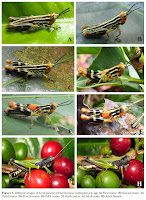 |
| Poecilocloeus coffeaphilus Cadena-Castañeda, Cardona & Constantino, in Constantino, Cadena-Castañeda, Granda, Machado et Botero, 2018. |
Abstract
A remarkable new species of Poecilocloeus (Orthoptera: Acrididae: Proctolabinae) found damaging coffee plantations in the Western Andes of Colombia is described and named Poecilocloeus coffeaphilus n. sp. This new species is part of a distinct and colorful group of Proctolabinae grasshoppers, with most species found at low altitudes in the rainforest of the Amazon basin. In contrast, the new species is found at elevations of 1600 to 1800 m in the canopy of dense cloud forests, in the southwestern part of the department of Antioquia (Western Cordillera, Colombian Andes). Information about the natural history, behavior, natural enemies and control strategies in coffee plantations is given for this new species of masked grasshopper. A key to the Neotropical species of the fruticolus species group is presented.
Key words. Andean region, Coffea arabica, biological control, coffee grasshopper.
 |
| Poecilocloeus coffeaphilus n. sp. (male). A) Adult male, lateral view. B) Dorsal view with right wing spread. |
Poecilocloeus coffeaphilus Cadena-Castañeda, Cardona and Constantino n. sp.
Common names. Masked coffee grasshopper, Coffee grasshopper and “grillo del café” or “saltamontes del café” in Spanish.
Comparison with similar species. This particular species can be differentiated from all others known of the fruticolus group by the atypical coloration of the completely black genicular lobe and hind tibiae (with only a small hint of magenta), structures which are reddish in the rest of the group (Fig. 3A and 4A). The dorsal stripe of the pronotal disc, so typical of the group, is reduced towards the prozona (Fig. 2B and 3C), a feature shared with P. cochleatus, although in the new species it is more reduced than in any other species. As for the male terminalia, this species has short and moderately stout cerci, similar to P. equatoriensis in a not so big dorsal protuberance and a mid-sized preapical prolongation on the lower margin, although in P. coffeaphilus n. sp. cerci are not as stout and the pallium is reduced (Fig. 2E). Regarding the phallic complex, this new species has the smaller ancorae of all known species of the genus, in which this structure is usually spine-shaped and well developed (Fig. 2F and 2G). Also, both pairs of valves are very characteristic in this new species, with very little resemblance to the other species of the fruticolus group.
 |
| Damage caused by nymphs of Poecilocloeus coffeaphilus n. sp. in the foliage of coffee trees. A-C, E, F) Scrapings on the leaf blade. D) Chewed-on and wilted apical shoots. |
Etymology. The name refers to the fact that this species feeds on the foliage of coffee plants (Coffea arabica Linnaeus, 1753).
Geographic distribution. The masked coffee grasshopper, Poecilocloeus coffeaphilus n. sp. appears to be endemic to southwest Antioquia in the municipalities of Concordia, Salgar and Betulia, on the Eastern slope of the Western Cordillera of Colombia in the Cauca River canyon (Map 1), where it is found in middle-elevation forests at 1600–1800 m asl.
Luis Miguel Constantino, Oscar J. Cadena-Castañeda, Juan Manuel Cardona Granda, Pablo Benavides Machado and Carmenza Góngora Botero. 2018. A new Colombian pest species of the Genus Poecilocloeus Bruner (Orthoptera: Acrididae: Proctolabinae) on Coffee, with A Key to the Neotropical Species. Insecta Mundi. 0621: 1–25. journals.flvc.org/Mundi/article/view/0621
Resumen. Una nueva y notable especie de Poecilocloeus (Orthoptera: Acrididae: Proctolabinae) encontrada afectando plantaciones de café en la cordillera occidental de Colombia es descrita y nombrada como P. coffeaphilus. La nueva especie hace parte de un grupo distintivo y colorido de saltamontes de la subfamilia Proctolabinae, con la mayoría de especies distribuidas a bajas altitudes en las selvas lluviosas de la cuenca amazónica. Por el contrario, la nueva especie se encuentra a altitudes entre 1.600 a 1.800 m en el dosel del bosque nublado, en el suroeste del departamento de Antioquia (Andes colombianos, Cordillera Occidental). Se da información acerca de la historia natural, comportamiento, enemigos naturales y estrategias de control de esta nueva especie de saltamonte enmascarado en cultivos de café. Se presenta una clave para las especies del grupo fruticolus de la región Neotropical.
Palabras clave. Región andina, Coffea arabica, control biológico, saltamontes del café.




